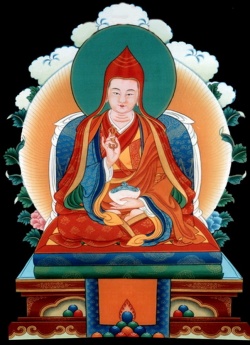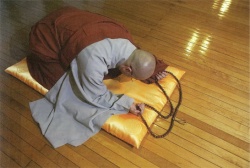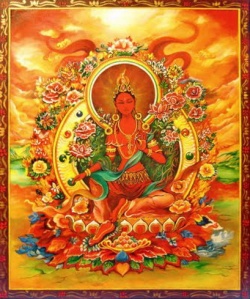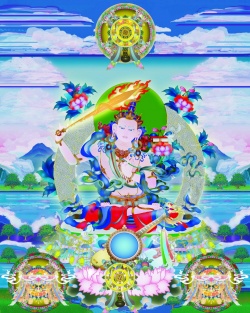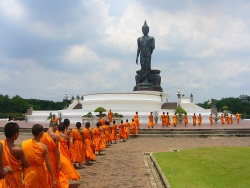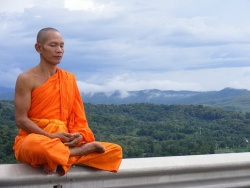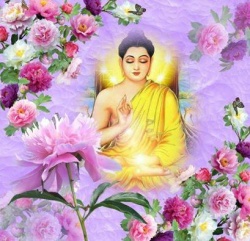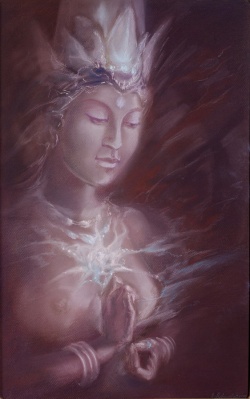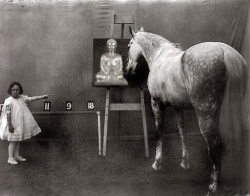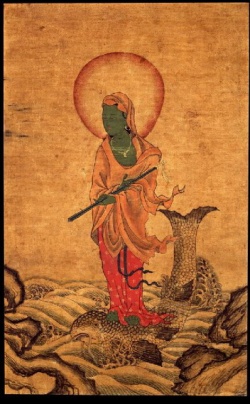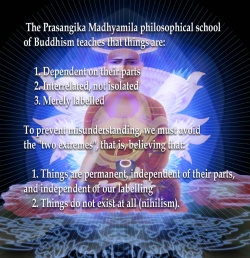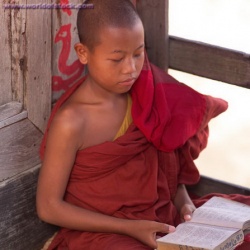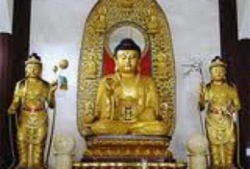Difference between revisions of "The Extended Universe Of The Northern Buddhists"
(Created page with " The Extended Universe Of The Northern Buddhists. Primitive Buddhism aimed at moral improvement and the Nirvâna—Its mythology was of pop...") |
|||
| (One intermediate revision by the same user not shown) | |||
| Line 1: | Line 1: | ||
| + | <nomobile>{{DisplayImages|333|1866|843|1606|1809|2464|2433|1883|3644|701|3144|2073|519|4527|2461|575|3517}}</nomobile> | ||
| Line 6: | Line 7: | ||
| − | + | The Extended [[Universe Of The Northern Buddhists]]. | |
| − | The Extended [[Universe | ||
[[Primitive Buddhism]] aimed at [[moral]] improvement and the [[Nirvâna]]—Its [[mythology]] was of popular growth—The [[Mahayana mythology]] was introduced by the [[metaphysicians]] of [[Buddhism]] itself—[[Nagarjuna]], | [[Primitive Buddhism]] aimed at [[moral]] improvement and the [[Nirvâna]]—Its [[mythology]] was of popular growth—The [[Mahayana mythology]] was introduced by the [[metaphysicians]] of [[Buddhism]] itself—[[Nagarjuna]], | ||
| Line 32: | Line 32: | ||
To this was added a legendary [[element]]. Long tales were invented to illustrate the great [[merits]] and [[powers]] of [[Buddha]]. | To this was added a legendary [[element]]. Long tales were invented to illustrate the great [[merits]] and [[powers]] of [[Buddha]]. | ||
| − | Free use was made in these [[Wikipedia:narrative|narratives]] of those vast periods of time into which the Hindoos divide the {{Wiki|past}} history of the [[world]]. | + | Free use was made in these [[Wikipedia:narrative|narratives]] of those vast periods of time into which the [[Hindoos]] divide the {{Wiki|past}} history of the [[world]]. |
The {{Wiki|biography}} of the great [[Wikipedia:Sage (sophos|sage]] was extended by attributing to him numberless [[previous lives]]. | The {{Wiki|biography}} of the great [[Wikipedia:Sage (sophos|sage]] was extended by attributing to him numberless [[previous lives]]. | ||
| − | The manner in which, from small beginnings, he rose by self-sacrificing and [[meritorious]] acts to be [[lord of the world]], and "[[teacher of gods and men]]" (t‘ien-jen-shï), is minutely recorded. | + | The manner in which, from small beginnings, he rose by self-sacrificing and [[meritorious]] acts to be [[lord of the world]], and "[[teacher of gods and men]]" ([[t‘ien-jen-shï]]), is minutely recorded. |
But the scene is not extended in any other way. New [[worlds]] are not invented in far distant [[space]]. | But the scene is not extended in any other way. New [[worlds]] are not invented in far distant [[space]]. | ||
| Line 42: | Line 42: | ||
The writers of these {{Wiki|legends}}, while they represent their [[hero]] as visiting the [[celestial]] regions to instruct their inhabitants, or as becoming by [[transmigration]] an inhabitant of those paradisiacal residences for long terms of years, do not transgress the limits of the popular [[Hindoo]] [[universe]]. | The writers of these {{Wiki|legends}}, while they represent their [[hero]] as visiting the [[celestial]] regions to instruct their inhabitants, or as becoming by [[transmigration]] an inhabitant of those paradisiacal residences for long terms of years, do not transgress the limits of the popular [[Hindoo]] [[universe]]. | ||
| − | The [[Northern]] [[Buddhists]], however, about the beginning of the [[Christian]] {{Wiki|era}}, pushed the bounds of their system much further. Men appeared at that time in [[Northern India]] devoted to [[metaphysical]] [[discussion]], who aimed to develop to the utmost the {{Wiki|principles}} of [[Buddhism]]. 1 | + | The [[Northern]] [[Buddhists]], however, about the beginning of the [[Christian]] {{Wiki|era}}, pushed the bounds of their system much further. |
| + | |||
| + | Men appeared at that time in [[Northern India]] devoted to [[metaphysical]] [[discussion]], who aimed to develop to the utmost the {{Wiki|principles}} of [[Buddhism]]. 1 | ||
In adding to the number of [[Buddhas]] and [[Bodhisattwas]], they felt it necessary to frame new [[worlds]] to serve as suitable [[abodes]] for them. With their peculiar [[philosophy]] it was easy to do this. Not believing in the [[existence]] of the | In adding to the number of [[Buddhas]] and [[Bodhisattwas]], they felt it necessary to frame new [[worlds]] to serve as suitable [[abodes]] for them. With their peculiar [[philosophy]] it was easy to do this. Not believing in the [[existence]] of the | ||
| Line 49: | Line 51: | ||
[[world]] of the [[senses]], there was no more difficulty in admitting to their system an [[unlimited]] number of fictitious [[worlds]] and fictitious [[Buddhas]] than in continuing to recognise the [[universe]] of their predecessors. | [[world]] of the [[senses]], there was no more difficulty in admitting to their system an [[unlimited]] number of fictitious [[worlds]] and fictitious [[Buddhas]] than in continuing to recognise the [[universe]] of their predecessors. | ||
| − | They named their system [[Mahayana]], Ta-ch‘eng, or "Great [[Development]]." | + | They named their system [[Mahayana]], [[Ta-ch‘eng]], or "Great [[Development]]." |
| − | Among these [[teachers]] the leading [[mind]] was [[Lung-shu]], or "[[Nagarjuna]]," as he is called by the Thibetans. | + | Among these [[teachers]] the leading [[mind]] was [[Lung-shu]], or "[[Nagarjuna]]," as he is called by the [[Thibetans]]. |
| − | [[Csoma Körösi]], cited in Hardy's Manual of [[Buddhism]], says, "With [[Nagarjuna]] originated what is known in Thibet as the [[Madhyamika]] system in [[philosophy]]. | + | [[Csoma Körösi]], cited in Hardy's Manual of [[Buddhism]], says, "With [[Nagarjuna]] originated what is known in [[Thibet]] as the [[Madhyamika]] system in [[philosophy]]. |
The [[philosophers]] in [[India]] had [[taught]] either a [[perpetual]] duration or a total {{Wiki|annihilation}} with [[respect]] to the [[soul]]. He chose a [[middle way]], hence the [[name]] of this [[sect]]." | The [[philosophers]] in [[India]] had [[taught]] either a [[perpetual]] duration or a total {{Wiki|annihilation}} with [[respect]] to the [[soul]]. He chose a [[middle way]], hence the [[name]] of this [[sect]]." | ||
| − | The {{Wiki|Chinese}} "Central [[Shastra]]" ([[Chung-lun]]), which bears his [[name]] as the author, contains this system, and his opinions may therefore be regarded as nearly those of the T‘ien-t‘ai school, whose [[doctrine]] is based on that work, and of which [[Lung-shu]] is consequently regarded as the first founder. | + | The {{Wiki|Chinese}} "Central [[Shastra]]" ([[Chung-lun]]), which bears his [[name]] as the author, contains this system, and his opinions may therefore be regarded as nearly those of the [[T‘ien-t‘ai school]], whose [[doctrine]] is based on that work, and of which [[Lung-shu]] is consequently regarded as the first founder. |
This circumstance throws {{Wiki|light}} on the [[objects]] of [[Lung-shu]] in composing the [[Sutras]] of which he was the author. For this school gives a symbolical [[interpretation]] to the [[mythology]] of the [[Buddhist]] [[books]]. | This circumstance throws {{Wiki|light}} on the [[objects]] of [[Lung-shu]] in composing the [[Sutras]] of which he was the author. For this school gives a symbolical [[interpretation]] to the [[mythology]] of the [[Buddhist]] [[books]]. | ||
| − | The very popular and influential [[Sutra]] called Hwa-yen-king came from the pen of [[Lung-shu]]. | + | The very popular and influential [[Sutra]] called [[Hwa-yen-king]] came from the pen of [[Lung-shu]]. |
| − | The {{Wiki|Chinese}} preface to that work says that [[Lung-shu | + | The {{Wiki|Chinese}} preface to that work says that [[Lung-shu p‘u-sa]], having exhausted the study of all [[human]] {{Wiki|literature}}, entered the [[Dragon]] palace to examine the [[Buddhist]] "[[pitaka]]" ([[san-tsang]]). He there found three [[forms]] of the [[Hwa-yen-king]]. |
The largest was divided into [[sections]] whose number is expressed by the {{Wiki|particles}} contained in a [[world]] of dust. The next consisted of twelve hundred [[sections]], and the smallest of forty-eight [[sections]]. | The largest was divided into [[sections]] whose number is expressed by the {{Wiki|particles}} contained in a [[world]] of dust. The next consisted of twelve hundred [[sections]], and the smallest of forty-eight [[sections]]. | ||
| Line 75: | Line 77: | ||
To afford room for the display of these [[attributes]], new [[worlds]] are located at [[pleasure]] in the [[boundless]] regions of [[space]]. But the whole of this imaginative creation was probably intended by the authors to be symbolical. | To afford room for the display of these [[attributes]], new [[worlds]] are located at [[pleasure]] in the [[boundless]] regions of [[space]]. But the whole of this imaginative creation was probably intended by the authors to be symbolical. | ||
| − | According to the explanation of the T‘ien-t‘ai school, and of the [[esoteric]] [[Buddhists]], the whole of this fictitious [[universe]] was meant to illustrate certain [[Buddhist]] {{Wiki|dogmas}}. | + | According to the explanation of the [[T‘ien-t‘ai]] school, and of the [[esoteric]] [[Buddhists]], the whole of this fictitious [[universe]] was meant to illustrate certain [[Buddhist]] {{Wiki|dogmas}}. |
It was the extreme {{Wiki|scepticism}} of the [[Buddhist philosophers]] that paved their way to this mode of [[teaching]] their system. | It was the extreme {{Wiki|scepticism}} of the [[Buddhist philosophers]] that paved their way to this mode of [[teaching]] their system. | ||
| − | In the T‘ien-t‘ai commentary on the Fa-hwa-king, the symbolical method of interpreting this [[mythological]] creation of the fancy may be seen exemplified.—(See Fa-hwa-hwei-i). | + | In the [[T‘ien-t‘ai]] commentary on the [[Fa-hwa-king]], the symbolical method of interpreting this [[mythological]] creation of the fancy may be seen exemplified.—(See [[Fa-hwa-hwei-i]]). |
Some specimens of this [[mythology]] will now be given. | Some specimens of this [[mythology]] will now be given. | ||
| − | The Hwa-yen-king says that, on one occasion, [[Buddha]] was presiding over an assembly at a place of meeting called [[Aranyaka]], in the {{Wiki|kingdom}} of [[Magadha]]. | + | The [[Hwa-yen-king]] says that, on one occasion, [[Buddha]] was presiding over an assembly at a place of meeting called [[Aranyaka]], in the {{Wiki|kingdom}} of [[Magadha]]. |
| + | |||
| + | He saw approaching a multitude of [[Bodhisattwas]] from distant [[worlds]]. | ||
| − | + | They asked to be instructed in regard to the "[[lands where the Buddhas resided]]." ([[Fo "ch‘ah]]," spelled in full in the old pronunciation, [[ch‘a-ta-la]]; in [[Sanscrit]], [[kshêtra]], "land." | |
1) [[Buddha]] accordingly entered on a description of the {{Wiki|kingdoms}} of the [[Buddhas]]. | 1) [[Buddha]] accordingly entered on a description of the {{Wiki|kingdoms}} of the [[Buddhas]]. | ||
| − | To the [[east]], after passing [[worlds]] {{Wiki|equal}} in number to the dust of ten of these {{Wiki|kingdoms}}, there is one termed the golden-coloured | + | To the [[east]], after passing [[worlds]] {{Wiki|equal}} in number to the dust of ten of these {{Wiki|kingdoms}}, there is one termed the [[golden-coloured world]]. |
The [[Buddha]] of "[[wisdom]] unmoved" presides there. | The [[Buddha]] of "[[wisdom]] unmoved" presides there. | ||
| − | [[Wen-shu]] (Manjusiri) and a crowd of other [[Bodhisattwas]] attend his instructions, as he sits on a [[lion]] dais surrounded by [[lotus flowers]]. | + | |
| + | [[Wen-shu]] ([[Manjusiri]]) and a crowd of other [[Bodhisattwas]] attend his instructions, as he sits on a [[lion]] dais surrounded by [[lotus flowers]]. | ||
To the [[south]], [[west]], and [[north]], and to the north-east, south-east, south-west, and north-west, are other [[worlds]] at a distance equally great. | To the [[south]], [[west]], and [[north]], and to the north-east, south-east, south-west, and north-west, are other [[worlds]] at a distance equally great. | ||
| Line 105: | Line 110: | ||
These names are formed symmetrically, and carry the reader and the worshipper round a circle of [[Buddhist]] [[ideas]]. | These names are formed symmetrically, and carry the reader and the worshipper round a circle of [[Buddhist]] [[ideas]]. | ||
| − | Thus the significations of the appellations given to the [[Buddhas]] are such as surpassing [[wisdom]], self-possessed [[wisdom]], [[Brahmanical | + | Thus the significations of the appellations given to the [[Buddhas]] are such as surpassing [[wisdom]], self-possessed [[wisdom]], [[Brahmanical wisdom]], &c. |
The leading [[Bodhisattwas]] receive such denominations as chief in the law, chief in [[merit]], chief in [[visual]] power, &c. | The leading [[Bodhisattwas]] receive such denominations as chief in the law, chief in [[merit]], chief in [[visual]] power, &c. | ||
| Line 115: | Line 120: | ||
Their [[metaphysical]] [[creed]] would prevent it, and there is not wanting such indirect {{Wiki|evidence}} to the fact as has been already adduced. | Their [[metaphysical]] [[creed]] would prevent it, and there is not wanting such indirect {{Wiki|evidence}} to the fact as has been already adduced. | ||
| − | But what shall be said to the [[morality]] of such modes of [[teaching]] a [[religion]]? These {{Wiki|sceptical}} writers cannot be shielded from the charge of practising a vast and systematic [[deception]] on the [[common people]], in inducing them to regard these [[imaginary]] [[beings]] with [[religious]] reverence. | + | But what shall be said to the [[morality]] of such modes of [[teaching]] a [[religion]]? |
| + | |||
| + | These {{Wiki|sceptical}} writers cannot be shielded from the charge of practising a vast and systematic [[deception]] on the [[common people]], in inducing them to regard these [[imaginary]] [[beings]] with [[religious]] reverence. | ||
Falsehood is involved in the very [[form]] of the [[Buddhist Sutras]], for they are attributed unhesitatingly in all their multitudinous variety and voluminous extent to [[Shakyamuni]] himself. | Falsehood is involved in the very [[form]] of the [[Buddhist Sutras]], for they are attributed unhesitatingly in all their multitudinous variety and voluminous extent to [[Shakyamuni]] himself. | ||
| Line 123: | Line 130: | ||
The practice of worshipping the [[divinities]] introduced in these new [[mythological]] creations was also directly encouraged, and this new [[idolatry]] spread with great rapidity throughout the countries where [[Northern Buddhism]] prevails. | The practice of worshipping the [[divinities]] introduced in these new [[mythological]] creations was also directly encouraged, and this new [[idolatry]] spread with great rapidity throughout the countries where [[Northern Buddhism]] prevails. | ||
| − | To illustrate these statements more fully, reference must be made to the more popular personages and better-known [[worlds]] in the new [[mythology | + | To illustrate these statements more fully, reference must be made to the more popular personages and better-known [[worlds]] in the new [[mythology]]. |
| − | In the Wu-liang-sheu-king ([[Amitabha Sutra]]), [[Buddha]] tells a tale of a [[king]] in a former [[kalpa]] who left the [[world]], adopted the monkish [[life]], assumed the [[name]] [[Fa-tsang]], "[[Treasure]] of the law," and became, by his rapid growth in [[knowledge]] and [[virtue]], a [[Bodhisattwa]]. | + | Among these fabled [[worlds]] located in distant [[space]], the best known is the [[paradise of Amitabha]]. |
| + | |||
| + | In the [[Wu-liang-sheu-king]] ([[Amitabha Sutra]]), [[Buddha]] tells a tale of a [[king]] in a former [[kalpa]] who left the [[world]], adopted the monkish [[life]], assumed the [[name]] [[Fa-tsang]], "[[Treasure]] of the law," and became, by his rapid growth in [[knowledge]] and [[virtue]], a [[Bodhisattwa]]. | ||
To the [[Buddha]] who was his [[teacher]] he uttered forty-eight wishes, having reference to the good he [[desired]] to accomplish for [[all living beings]], if he should attain the rank of [[Buddha]]. | To the [[Buddha]] who was his [[teacher]] he uttered forty-eight wishes, having reference to the good he [[desired]] to accomplish for [[all living beings]], if he should attain the rank of [[Buddha]]. | ||
| Line 131: | Line 140: | ||
Ten [[kalpas]] since, he received that title with the [[name]] "[[Amitabha]]" ([[O-mi-to Fo]]), and now resides in a [[world]] far in the [[West]], to fulfil his forty-eight wishes for the [[benefit]] of mankind. Ten million {{Wiki|kingdoms}} of [[Buddhas]] separate his [[world]] from our [[own]]. | Ten [[kalpas]] since, he received that title with the [[name]] "[[Amitabha]]" ([[O-mi-to Fo]]), and now resides in a [[world]] far in the [[West]], to fulfil his forty-eight wishes for the [[benefit]] of mankind. Ten million {{Wiki|kingdoms}} of [[Buddhas]] separate his [[world]] from our [[own]]. | ||
| − | It is composed of {{Wiki|gold}}, {{Wiki|silver}}, [[lapis-lazuli]], [[coral]], {{Wiki|amber}}, a stone called ch‘a-ku, and cornelian. | + | It is composed of {{Wiki|gold}}, {{Wiki|silver}}, [[lapis-lazuli]], [[coral]], {{Wiki|amber}}, a stone called [[ch‘a-ku]], and cornelian. |
There is there no [[Sumeru mountain]], nor {{Wiki|iron}} mountain girdle, nor are there any prisons for {{Wiki|punishment}}. | There is there no [[Sumeru mountain]], nor {{Wiki|iron}} mountain girdle, nor are there any prisons for {{Wiki|punishment}}. | ||
| Line 141: | Line 150: | ||
Birds of the most beautiful plumage sing day and night of the five {{Wiki|principles}} of [[virtue]], the five sources of [[moral]] power, and the seven steps in [[knowledge]]. | Birds of the most beautiful plumage sing day and night of the five {{Wiki|principles}} of [[virtue]], the five sources of [[moral]] power, and the seven steps in [[knowledge]]. | ||
| − | The listener is so affected by their [[music]], that he can think only of [[Buddha]], the Law, and the Priesthood. The [[life-time]] of this [[Buddha]] is without limit, lasting through countless [[kalpas]], and therefore he is called "[[Amitabha]]" (Wu-liang-sheu, "[[Boundless]] age"). | + | The listener is so affected by their [[music]], that he can think only of [[Buddha]], the [[Law]], and the [[Priesthood]]. |
| + | |||
| + | The [[life-time]] of this [[Buddha]] is without limit, lasting through countless [[kalpas]], and therefore he is called "[[Amitabha]]" ([[Wu-liang-sheu]], "[[Boundless]] age"). | ||
Two [[Bodhisattwas]] reside there, anxious to save a multitude of [[living beings]], who, with [[Amitabha]], are worshipped {{Wiki|assiduously}} by the [[Northern]] [[Buddhists]]. | Two [[Bodhisattwas]] reside there, anxious to save a multitude of [[living beings]], who, with [[Amitabha]], are worshipped {{Wiki|assiduously}} by the [[Northern]] [[Buddhists]]. | ||
| − | They are, says the Wu-liang-sheu-king, Kwan-shï-yin and [[Ta-shï-chï]]. They radiate {{Wiki|light}} over three thousand great [[worlds]]. | + | They are, says the [[Wu-liang-sheu-king]], [[Kwan-shï-yin]] and [[Ta-shï-chï]]. |
| + | |||
| + | They radiate {{Wiki|light}} over three thousand great [[worlds]]. | ||
They [[attained]] their rank by [[good deeds]] performed in our [[own]] [[world]], and were rewarded by [[birth]] into the [[Western paradise]] of [[Amitabha]]. | They [[attained]] their rank by [[good deeds]] performed in our [[own]] [[world]], and were rewarded by [[birth]] into the [[Western paradise]] of [[Amitabha]]. | ||
| Line 151: | Line 164: | ||
The [[Amitabha Sutra]], after minutely dilating on this [[paradise]], describes nine other [[worlds]] at a [[corresponding]] distance from our [[own]], and occupying, as in the former case, the [[cardinal points]] and [[intermediate]] positions, with the [[zenith]] and [[nadir]]. | The [[Amitabha Sutra]], after minutely dilating on this [[paradise]], describes nine other [[worlds]] at a [[corresponding]] distance from our [[own]], and occupying, as in the former case, the [[cardinal points]] and [[intermediate]] positions, with the [[zenith]] and [[nadir]]. | ||
| − | Ach‘obhya and other [[Buddhas]] {{Wiki|rule}} in the [[East]], numerous as the sands of the [[Ganges]], each proclaiming the [[doctrine]] that instructs and saves to the inhabitants of his [[own]] {{Wiki|kingdom}} | + | [[Ach‘obhya]] and other [[Buddhas]] {{Wiki|rule}} in the [[East]], numerous as the sands of the [[Ganges]], each proclaiming the [[doctrine]] that instructs and saves to the inhabitants of his [[own]] {{Wiki|kingdom}}. |
| − | + | A similar account is given of the other [[worlds]] and their [[Buddhas]]. | |
| − | These three works [[form]] the textbooks of the Tsing-tu school, whose very numerous publications, suited to the popular {{Wiki|taste}}, and based on the [[doctrine]] of these [[Sutras]], are very widely disseminated among the {{Wiki|Chinese people}} at the {{Wiki|present}} day. | + | The two [[Sutras]] already cited, together with one called [[Kwan-wu-liang-sheu-king]], are entirely occupied with [[Amitabha]] and his [[paradise]]. |
| + | |||
| + | These three works [[form]] the textbooks of the [[Tsing-tu school]], whose very numerous publications, suited to the popular {{Wiki|taste}}, and based on the [[doctrine]] of these [[Sutras]], are very widely disseminated among the {{Wiki|Chinese people}} at the {{Wiki|present}} day. | ||
In the last-mentioned work, [[Buddha]], when seated in the midst of his [[disciples]], is said to have poured forth from his [[eyebrows]] a flood of [[golden light]] which shone to all the surrounding [[worlds]]. | In the last-mentioned work, [[Buddha]], when seated in the midst of his [[disciples]], is said to have poured forth from his [[eyebrows]] a flood of [[golden light]] which shone to all the surrounding [[worlds]]. | ||
| Line 165: | Line 180: | ||
One was [[constructed]] of the Seven [[precious]] stones and metals, another of [[lotus flowers]], another was like the palace of [[Ishwara]], another like a [[crystal mirror]]. | One was [[constructed]] of the Seven [[precious]] stones and metals, another of [[lotus flowers]], another was like the palace of [[Ishwara]], another like a [[crystal mirror]]. | ||
| − | A [[disciple]], struck by this magnificent display, | + | A [[disciple]], struck by this magnificent display, expressed a [[desire]] to be born in the [[Western heaven]], and [[Buddha]] told him how he might have his [[desire]] gratified. |
| − | |||
| − | |||
| − | |||
| − | expressed a [[desire]] to be born in the [[Western heaven]], and [[Buddha]] told him how he might have his [[desire]] gratified. | ||
This is an example of the manner in which the inventors of this [[mythology]] intended, by scenes of vastness and [[splendour]], to affect the reader's or listener's [[mind]]. [[Feelings]] favourable to the influence of [[Buddhist]] [[ideas]] were thus to be called into [[action]]. | This is an example of the manner in which the inventors of this [[mythology]] intended, by scenes of vastness and [[splendour]], to affect the reader's or listener's [[mind]]. [[Feelings]] favourable to the influence of [[Buddhist]] [[ideas]] were thus to be called into [[action]]. | ||
| Line 178: | Line 189: | ||
This personage, when he was a [[Bodhisattwa]], uttered twelve great wishes for the [[benefit]] of [[living beings]], [[including]] the removal of various [[bodily]] and [[mental]] {{Wiki|calamities}} from those who are afflicted with them, and the lengthening of their [[life]]. | This personage, when he was a [[Bodhisattwa]], uttered twelve great wishes for the [[benefit]] of [[living beings]], [[including]] the removal of various [[bodily]] and [[mental]] {{Wiki|calamities}} from those who are afflicted with them, and the lengthening of their [[life]]. | ||
| + | |||
Hence his [[name]], "The [[healing]] [[Teacher]]." | Hence his [[name]], "The [[healing]] [[Teacher]]." | ||
| − | |||
| − | The [[world]] in which he resides is composed of [[lapis-lazuli]], its walls and {{Wiki|palaces}} of the seven [[precious]] stones and metals, its streets of {{Wiki|gold}}, thus resembling, as is observed by the author of the Yo-shï-king, the Ki-to-shï-kiai, or "[[Paradise | + | In attendance on him are two leading [[Bodhisattwas]], whose names, [[Ji-kwang-pien-chau]], and [[Yue-kwang-pien-chau]], signify the "[[Far-shining light of the sun and of the [moon]]." |
| + | |||
| + | The [[world]] in which he resides is composed of [[lapis-lazuli]], its walls and {{Wiki|palaces}} of the seven [[precious]] stones and metals, its streets of {{Wiki|gold}}, thus resembling, as is observed by the author of the [[Yo-shï-king]], the [[Ki-to-shï-kiai]], or "[[Paradise of Amitabha]]." | ||
He is worshipped as a [[deity]] who removes [[sufferings]] and lengthens [[life]], and is in fact the [[symbol]] of these [[ideas]]. | He is worshipped as a [[deity]] who removes [[sufferings]] and lengthens [[life]], and is in fact the [[symbol]] of these [[ideas]]. | ||
| Line 189: | Line 202: | ||
While many of the fabulous [[beings]] introduced in the {{Wiki|literature}} of [[Northern Buddhism]] have no image or [[shrine]] in the [[temples]] of the {{Wiki|present}} day, [[Yo-shï Fo]] is one of those who are very seldom omitted in the arrangement of these edifices. | While many of the fabulous [[beings]] introduced in the {{Wiki|literature}} of [[Northern Buddhism]] have no image or [[shrine]] in the [[temples]] of the {{Wiki|present}} day, [[Yo-shï Fo]] is one of those who are very seldom omitted in the arrangement of these edifices. | ||
| − | The freedom of [[imagination]] in creating new [[worlds]] and new [[deities]], in which the authors of this {{Wiki|literature}} indulged, would naturally lead to incongruities. Newly-invented [[worlds]] would be located in regions already appropriated by previous writers. In the Fa-hwa-king, a circle of eight [[worlds]], with two [[Buddhas]] to each, is described. | + | The freedom of [[imagination]] in creating new [[worlds]] and new [[deities]], in which the authors of this {{Wiki|literature}} indulged, would naturally lead to incongruities. Newly-invented [[worlds]] would be located in regions already appropriated by previous writers. |
| + | |||
| + | In the [[Fa-hwa-king]], a circle of eight [[worlds]], with two [[Buddhas]] to each, is described. | ||
| − | [[Amitabha]] and Ach‘obhya occur in the [[west]] and [[east]] respectively, the account agreeing in this [[respect]] with that in the [[Amitabha Sutra]], but the other names do not harmonise; | + | [[Amitabha]] and [[Ach‘obhya]] occur in the [[west]] and [[east]] respectively, the account agreeing in this [[respect]] with that in the [[Amitabha Sutra]], but the other names do not harmonise; |
so that in several cases new [[Buddhas]] are [[imagined]] in regions preoccupied by those created at an earlier date. | so that in several cases new [[Buddhas]] are [[imagined]] in regions preoccupied by those created at an earlier date. | ||
| Line 197: | Line 212: | ||
Accounts of many more of these fancied [[worlds]] might be collected from other works. | Accounts of many more of these fancied [[worlds]] might be collected from other works. | ||
| − | For example, in the Pei-hwa-king, one in the south-east with its [[Buddha]], is described with minuteness. | + | For example, in the [[Pei-hwa-king]], one in the south-east with its [[Buddha]], is described with minuteness. |
The symbolical [[character]] of this [[mythology]] is seen very clearly in the [[attributes]] of the [[Bodhisattwas]], who play in it such an important part, and who are the [[objects]] of such extended popular {{Wiki|worship}} in the [[Buddhist]] countries of the [[North]]. | The symbolical [[character]] of this [[mythology]] is seen very clearly in the [[attributes]] of the [[Bodhisattwas]], who play in it such an important part, and who are the [[objects]] of such extended popular {{Wiki|worship}} in the [[Buddhist]] countries of the [[North]]. | ||
| Line 211: | Line 226: | ||
If, as some think, the {{Wiki|pantheism}} of {{Wiki|Germany}} will, according to the common law of progress in [[human]] perversity, result in [[polytheism]], we have here an example of the way in which such a new [[idolatry]] will possibly be introduced. | If, as some think, the {{Wiki|pantheism}} of {{Wiki|Germany}} will, according to the common law of progress in [[human]] perversity, result in [[polytheism]], we have here an example of the way in which such a new [[idolatry]] will possibly be introduced. | ||
| − | I append here some further account of Manjusiri, the [[Bodhisattwa]] honoured at Wu-t‘ai shah in [[North China]]. | + | I append here some further account of [[Manjusiri]], the [[Bodhisattwa]] honoured at [[Wu-t‘ai shah]] in [[North China]]. |
These notices will also show how in the expansion of the [[mythology]] which we meet with in the [[Sutras]] of the Great [[Development]], even [[China]] is made one of the countries, and Wu-t‘ai [[one of the mountains]], where [[Buddha]] delivered [[discourses]]. | These notices will also show how in the expansion of the [[mythology]] which we meet with in the [[Sutras]] of the Great [[Development]], even [[China]] is made one of the countries, and Wu-t‘ai [[one of the mountains]], where [[Buddha]] delivered [[discourses]]. | ||
| − | |||
| − | [ | + | We learn from the {{Wiki|Mongol}} account of [[Wu-t‘ai]], that [[Manjusiri]] is addressed in [[prayer]] as the [[enlightener]] of the [[world]]. |
| + | |||
| + | His [[wisdom]] is {{Wiki|perfect}}, and is symbolised by the sword he holds in his right hand; because his [[intellect]] pierces the deepest recesses of [[Buddhist]] [[thought]], and cuts knots which cannot otherwise be solved. | ||
He is also represented as holding in his hand a volume of [[Buddha's teaching]], of which a [[flower]] is the [[symbol]]. He is styled also the [[lamp of wisdom]] and of [[supernatural power]]. | He is also represented as holding in his hand a volume of [[Buddha's teaching]], of which a [[flower]] is the [[symbol]]. He is styled also the [[lamp of wisdom]] and of [[supernatural power]]. | ||
| Line 223: | Line 239: | ||
He is said to drive away falsehood and [[ignorance]] from the [[minds]] of [[all living beings]], and on this ground the [[lama]] who compiles the [[books]] prays to him for [[knowledge]] in reverential terms. | He is said to drive away falsehood and [[ignorance]] from the [[minds]] of [[all living beings]], and on this ground the [[lama]] who compiles the [[books]] prays to him for [[knowledge]] in reverential terms. | ||
| − | The Hwa-yen-king, called in {{Wiki|Mongol}} Olanggi sodar, is cited in this work as recording an assembly of numberless [[Bodhisattwas]] at Wu-t‘ai, among whom Manjusiri is conspicuous in power and in honour. | + | The [[Hwa-yen-king]], called in {{Wiki|Mongol}} [[Olanggi sodar]], is cited in this work as recording an assembly of numberless [[Bodhisattwas]] at [[Wu-t‘ai]], among whom [[Manjusiri]] is conspicuous in power and in honour. |
To [[faithful]] [[Buddhists]], the mention, in a [[discourse]] of [[Buddha]], of a {{Wiki|Chinese}} mountain, is {{Wiki|evidence}} of the superhuman [[knowledge]] of the [[Wikipedia:Sage (sophos|sage]]. | To [[faithful]] [[Buddhists]], the mention, in a [[discourse]] of [[Buddha]], of a {{Wiki|Chinese}} mountain, is {{Wiki|evidence}} of the superhuman [[knowledge]] of the [[Wikipedia:Sage (sophos|sage]]. | ||
| Line 229: | Line 245: | ||
But as we know that [[Nagarjuna]] was the real writer of this work, we look upon it rather as [[proof]] that the {{Wiki|geography}} of [[China]] was known to the [[translators]] of the works of this copious author, and that they lived in a time when this mountain had already become a favourite abode of the {{Wiki|devotees}} of this [[religion]] in that country. | But as we know that [[Nagarjuna]] was the real writer of this work, we look upon it rather as [[proof]] that the {{Wiki|geography}} of [[China]] was known to the [[translators]] of the works of this copious author, and that they lived in a time when this mountain had already become a favourite abode of the {{Wiki|devotees}} of this [[religion]] in that country. | ||
| − | In another [[book]] quoted by the author, Manjusiri is informed by [[Buddha]], that it is his [[duty]] to seek the instruction and {{Wiki|salvation}} of the {{Wiki|Chinese}} by making his home at Wu-t‘ai, and there causing the [[wheel of the law]] to revolve incessantly on the [[five mountains]] of the five different colours, and crowned by five variously-shaped [[pagodas]]. | + | In another [[book]] quoted by the author, [[Manjusiri]] is informed by [[Buddha]], that it is his [[duty]] to seek the instruction and {{Wiki|salvation}} of the {{Wiki|Chinese}} by making his home at Wu-t‘ai, and there causing the [[wheel of the law]] to revolve incessantly on the [[five mountains]] of the five different colours, and crowned by five variously-shaped [[pagodas]]. |
| − | The [[lotus]] will not grow at Wu-t‘ai. | + | The [[lotus]] will not grow at [[Wu-t‘ai]]. |
| − | It is too cold. How shall Manjusiri be born from its ample couch of leaves? | + | It is too cold. How shall [[Manjusiri]] be born from its ample couch of leaves? |
| − | The | + | The [[magical]] power of [[Buddha]] [[causes]] a [[lotus]] to grow from the seed of a certain [[tree]]. |
| − | The [[translators]] of the [[Mahayana Sutras]] in the T‘ang | + | Thus he was without father or mother, and was not stained with the "pollution of the common [[world]]" (orchilang). |
| + | |||
| + | The legend of [[Manjusiri]] at [[Wu-t‘ai]] seemed to require the authority of [[Buddha]]. | ||
| + | |||
| + | The [[translators]] of the [[Mahayana Sutras]] in the [[T‘ang dynasty]]—in order to supply this want—did not scruple to insert what they [[pleased]] in their translations. | ||
Certainly Wu-t‘ai was not a [[Buddhist]] establishment till some centuries after [[Nagarjuna]]. | Certainly Wu-t‘ai was not a [[Buddhist]] establishment till some centuries after [[Nagarjuna]]. | ||
| − | If some [[Sanscrit]] [[scholar]] would consult the | + | If some [[Sanscrit]] [[scholar]] would consult the [[Nepalese]] [[Hwa-yen-king]], he would probably find nothing there about [[Wu-t‘ai shan]]. |
It would be curious to note what the original says in those passages where [[China]] is introduced by the [[translators]]. | It would be curious to note what the original says in those passages where [[China]] is introduced by the [[translators]]. | ||
| + | |||
| + | |||
Footnotes | Footnotes | ||
| + | |||
| + | |||
229:1 Vide [[Burnouf's]] account of the third [[Buddhist council]] held in Cashmere, in his Introduction à l’Histoire du Buddhisme Indien. | 229:1 Vide [[Burnouf's]] account of the third [[Buddhist council]] held in Cashmere, in his Introduction à l’Histoire du Buddhisme Indien. | ||
| − | 231:1 The {{Wiki|dictionary}} Yi-ts‘ie-king-yin-i adds, that this [[word]], used for "land or "{{Wiki|kingdom}}," is the [[root]] of the [[word]] [[Kshatrya]], the second of the [[four castes]], to which belong the {{Wiki|royal}} families of [[India]], the [[Kshatryas]] being [[Lords]] of the soil. | + | 231:1 The {{Wiki|dictionary}} [[Yi-ts‘ie-king-yin-i]] adds, that this [[word]], used for "land or "{{Wiki|kingdom}}," is the [[root]] of the [[word]] [[Kshatrya]], the second of the [[four castes]], to which belong the {{Wiki|royal}} families of [[India]], the [[Kshatryas]] being [[Lords]] of the soil. |
{{R}} | {{R}} | ||
http://www.sacred-texts.com/bud/cbu/cbu18.htm | http://www.sacred-texts.com/bud/cbu/cbu18.htm | ||
[[Category:Buddhist Cosmology]] | [[Category:Buddhist Cosmology]] | ||
Latest revision as of 06:35, 5 February 2016
The Extended Universe Of The Northern Buddhists.
Primitive Buddhism aimed at moral improvement and the Nirvâna—Its mythology was of popular growth—The Mahayana mythology was introduced by the metaphysicians of Buddhism itself—Nagarjuna,
the chief inventor—Hwa-yen-king—An extended universe invented to illustrate dogma—Ten worlds beyond the Saha world in ten different directions—New divinities to worship—Amitabha—His world in the West—Kwan-yin and Ta-shï-chï—The world of Ach‘obhya Buddha in the East—World of Yo-shï Fo, the healing teacher—Mercy, wisdom, &c., are symbolised in the Bodhisattwas—Wu-t‘ai shan in China is introduced in the Hwa-yen-king.
ABOUT four centuries after the time of Shakyamuni, or Gautama as he is more commonly called in Birmah and Ceylon, a great increase to the Sanscrit literature of the Buddhist religion began to be made.
Very little had been added to the national mythology by the founder and first propagators of this system, except what respected Buddha himself.
Their aim was to inculcate virtue, encourage the ascetic life, and urge persons of all castes and both sexes to aim at deliverance from the evils of existence and the attainment of the Nirvâna.
They based their teaching on the existing doctrine of metempsychosis, of the gods and other classes of beings, and of heaven and hell.
These had been united from the earliest infancy of the Hindoo nation in one system. By the transmigration of souls, all in heaven or earth, whether gods, men, demons, or inferior animals, are linked together into one chain of animated existence, and compose one world.
It is the business of a Buddha and a Bodhisattwa to instruct these beings in moral truths, and assist them to escape from all the six forms of life, into a state of perfect enlightenment and tranquillity.
The mythological element, as it existed in early Buddhism, was even then an old creation of the popular mind that had grown up with the first literary efforts of the nation.
In this respect it agrees with most other mythologies, in the fact of its originating, not in philosophical schools, but among the people themselves.
To this was added a legendary element. Long tales were invented to illustrate the great merits and powers of Buddha.
Free use was made in these narratives of those vast periods of time into which the Hindoos divide the past history of the world.
The biography of the great sage was extended by attributing to him numberless previous lives.
The manner in which, from small beginnings, he rose by self-sacrificing and meritorious acts to be lord of the world, and "teacher of gods and men" (t‘ien-jen-shï), is minutely recorded.
But the scene is not extended in any other way. New worlds are not invented in far distant space.
The writers of these legends, while they represent their hero as visiting the celestial regions to instruct their inhabitants, or as becoming by transmigration an inhabitant of those paradisiacal residences for long terms of years, do not transgress the limits of the popular Hindoo universe.
The Northern Buddhists, however, about the beginning of the Christian era, pushed the bounds of their system much further.
Men appeared at that time in Northern India devoted to metaphysical discussion, who aimed to develop to the utmost the principles of Buddhism. 1
In adding to the number of Buddhas and Bodhisattwas, they felt it necessary to frame new worlds to serve as suitable abodes for them. With their peculiar philosophy it was easy to do this. Not believing in the existence of the
world of the senses, there was no more difficulty in admitting to their system an unlimited number of fictitious worlds and fictitious Buddhas than in continuing to recognise the universe of their predecessors.
They named their system Mahayana, Ta-ch‘eng, or "Great Development."
Among these teachers the leading mind was Lung-shu, or "Nagarjuna," as he is called by the Thibetans.
Csoma Körösi, cited in Hardy's Manual of Buddhism, says, "With Nagarjuna originated what is known in Thibet as the Madhyamika system in philosophy.
The philosophers in India had taught either a perpetual duration or a total annihilation with respect to the soul. He chose a middle way, hence the name of this sect."
The Chinese "Central Shastra" (Chung-lun), which bears his name as the author, contains this system, and his opinions may therefore be regarded as nearly those of the T‘ien-t‘ai school, whose doctrine is based on that work, and of which Lung-shu is consequently regarded as the first founder.
This circumstance throws light on the objects of Lung-shu in composing the Sutras of which he was the author. For this school gives a symbolical interpretation to the mythology of the Buddhist books.
The very popular and influential Sutra called Hwa-yen-king came from the pen of Lung-shu.
The Chinese preface to that work says that Lung-shu p‘u-sa, having exhausted the study of all human literature, entered the Dragon palace to examine the Buddhist "pitaka" (san-tsang). He there found three forms of the Hwa-yen-king.
The largest was divided into sections whose number is expressed by the particles contained in a world of dust. The next consisted of twelve hundred sections, and the smallest of forty-eight sections.
The last and least he gave to the world with its present title, and he must therefore be regarded as its author.
This and other works of the Great Development class contain a great extension of the mythological element of Buddhism.
Many new Buddhas and Bodhisattwas here appear, distinguished by various high attributes of goodness, knowledge, and magical power.
To afford room for the display of these attributes, new worlds are located at pleasure in the boundless regions of space. But the whole of this imaginative creation was probably intended by the authors to be symbolical.
According to the explanation of the T‘ien-t‘ai school, and of the esoteric Buddhists, the whole of this fictitious universe was meant to illustrate certain Buddhist dogmas.
It was the extreme scepticism of the Buddhist philosophers that paved their way to this mode of teaching their system.
In the T‘ien-t‘ai commentary on the Fa-hwa-king, the symbolical method of interpreting this mythological creation of the fancy may be seen exemplified.—(See Fa-hwa-hwei-i).
Some specimens of this mythology will now be given.
The Hwa-yen-king says that, on one occasion, Buddha was presiding over an assembly at a place of meeting called Aranyaka, in the kingdom of Magadha.
He saw approaching a multitude of Bodhisattwas from distant worlds.
They asked to be instructed in regard to the "lands where the Buddhas resided." (Fo "ch‘ah," spelled in full in the old pronunciation, ch‘a-ta-la; in Sanscrit, kshêtra, "land."
1) Buddha accordingly entered on a description of the kingdoms of the Buddhas.
To the east, after passing worlds equal in number to the dust of ten of these kingdoms, there is one termed the golden-coloured world.
The Buddha of "wisdom unmoved" presides there.
Wen-shu (Manjusiri) and a crowd of other Bodhisattwas attend his instructions, as he sits on a lion dais surrounded by lotus flowers.
To the south, west, and north, and to the north-east, south-east, south-west, and north-west, are other worlds at a distance equally great.
Towards the zenith and nadir two other worlds make up the number ten, each having a governing Buddha, and a countless number of Bodhisattwas, who perform to him an act of worship, and humbly receive his instructions.
The same work also describes the ten worlds that come next to the one in which we live, on the east, south, west, and north, and the other directions as before. Each of them is ruled by a Buddha, to whom prayers are to be offered, in which he is to be addressed under ten different names.
The moral import of these worlds and their Buddhas is contained in the names that are given them.
These names are formed symmetrically, and carry the reader and the worshipper round a circle of Buddhist ideas.
Thus the significations of the appellations given to the Buddhas are such as surpassing wisdom, self-possessed wisdom, Brahmanical wisdom, &c.
The leading Bodhisattwas receive such denominations as chief in the law, chief in merit, chief in visual power, &c.
It was thus that these Buddhist philosophers employed the imagination as an instrument of moral instruction, just as western authors write a poem or a novel for a similar end.
They were men whose minds were cultivated to the utmost subtlety in argument, as the Shastras, works by the same authors, and taken up exclusively with philosophical discussions, abundantly show. They did not, therefore, believe in the truth of these fanciful creations.
Their metaphysical creed would prevent it, and there is not wanting such indirect evidence to the fact as has been already adduced.
But what shall be said to the morality of such modes of teaching a religion?
These sceptical writers cannot be shielded from the charge of practising a vast and systematic deception on the common people, in inducing them to regard these imaginary beings with religious reverence.
Falsehood is involved in the very form of the Buddhist Sutras, for they are attributed unhesitatingly in all their multitudinous variety and voluminous extent to Shakyamuni himself.
Ananda, the cousin and favourite disciple of the sage in his declining years, is put forward as the compiler from memory of all these works.
The practice of worshipping the divinities introduced in these new mythological creations was also directly encouraged, and this new idolatry spread with great rapidity throughout the countries where Northern Buddhism prevails.
To illustrate these statements more fully, reference must be made to the more popular personages and better-known worlds in the new mythology.
Among these fabled worlds located in distant space, the best known is the paradise of Amitabha.
In the Wu-liang-sheu-king (Amitabha Sutra), Buddha tells a tale of a king in a former kalpa who left the world, adopted the monkish life, assumed the name Fa-tsang, "Treasure of the law," and became, by his rapid growth in knowledge and virtue, a Bodhisattwa.
To the Buddha who was his teacher he uttered forty-eight wishes, having reference to the good he desired to accomplish for all living beings, if he should attain the rank of Buddha.
Ten kalpas since, he received that title with the name "Amitabha" (O-mi-to Fo), and now resides in a world far in the West, to fulfil his forty-eight wishes for the benefit of mankind. Ten million kingdoms of Buddhas separate his world from our own.
It is composed of gold, silver, lapis-lazuli, coral, amber, a stone called ch‘a-ku, and cornelian.
There is there no Sumeru mountain, nor iron mountain girdle, nor are there any prisons for punishment.
There is no fear of becoming a hungry ghost, or an animal by transmigration, for such modes of life are unknown there.
There are all kinds of beautiful flowers, which the inhabitants pluck to present as offerings to the thousands and millions of Buddhas that reside in other parts of space.
Birds of the most beautiful plumage sing day and night of the five principles of virtue, the five sources of moral power, and the seven steps in knowledge.
The listener is so affected by their music, that he can think only of Buddha, the Law, and the Priesthood.
The life-time of this Buddha is without limit, lasting through countless kalpas, and therefore he is called "Amitabha" (Wu-liang-sheu, "Boundless age").
Two Bodhisattwas reside there, anxious to save a multitude of living beings, who, with Amitabha, are worshipped assiduously by the Northern Buddhists.
They are, says the Wu-liang-sheu-king, Kwan-shï-yin and Ta-shï-chï.
They radiate light over three thousand great worlds.
They attained their rank by good deeds performed in our own world, and were rewarded by birth into the Western paradise of Amitabha.
The Amitabha Sutra, after minutely dilating on this paradise, describes nine other worlds at a corresponding distance from our own, and occupying, as in the former case, the cardinal points and intermediate positions, with the zenith and nadir.
Ach‘obhya and other Buddhas rule in the East, numerous as the sands of the Ganges, each proclaiming the doctrine that instructs and saves to the inhabitants of his own kingdom.
A similar account is given of the other worlds and their Buddhas.
The two Sutras already cited, together with one called Kwan-wu-liang-sheu-king, are entirely occupied with Amitabha and his paradise.
These three works form the textbooks of the Tsing-tu school, whose very numerous publications, suited to the popular taste, and based on the doctrine of these Sutras, are very widely disseminated among the Chinese people at the present day.
In the last-mentioned work, Buddha, when seated in the midst of his disciples, is said to have poured forth from his eyebrows a flood of golden light which shone to all the surrounding worlds.
This light returning was seen by the assembly to form itself into a golden tower on Buddha's head.
It was like the Sumeru mountain, and by its splendour many kingdoms of Buddhas were revealed to view.
One was constructed of the Seven precious stones and metals, another of lotus flowers, another was like the palace of Ishwara, another like a crystal mirror.
A disciple, struck by this magnificent display, expressed a desire to be born in the Western heaven, and Buddha told him how he might have his desire gratified.
This is an example of the manner in which the inventors of this mythology intended, by scenes of vastness and splendour, to affect the reader's or listener's mind. Feelings favourable to the influence of Buddhist ideas were thus to be called into action.
Another of these creations which has gained considerable notoriety is a world in the East ruled by Yo-shï Fo (Bhaishajyaguru Buddha).
There intervene between that world and ours, kingdoms of Buddhas to the number of ten times the sands of the Ganges.
This personage, when he was a Bodhisattwa, uttered twelve great wishes for the benefit of living beings, including the removal of various bodily and mental calamities from those who are afflicted with them, and the lengthening of their life.
Hence his name, "The healing Teacher."
In attendance on him are two leading Bodhisattwas, whose names, Ji-kwang-pien-chau, and Yue-kwang-pien-chau, signify the "[[Far-shining light of the sun and of the [moon]]."
The world in which he resides is composed of lapis-lazuli, its walls and palaces of the seven precious stones and metals, its streets of gold, thus resembling, as is observed by the author of the Yo-shï-king, the Ki-to-shï-kiai, or "Paradise of Amitabha."
He is worshipped as a deity who removes sufferings and lengthens life, and is in fact the symbol of these ideas.
While many of the fabulous beings introduced in the literature of Northern Buddhism have no image or shrine in the temples of the present day, Yo-shï Fo is one of those who are very seldom omitted in the arrangement of these edifices.
The freedom of imagination in creating new worlds and new deities, in which the authors of this literature indulged, would naturally lead to incongruities. Newly-invented worlds would be located in regions already appropriated by previous writers.
In the Fa-hwa-king, a circle of eight worlds, with two Buddhas to each, is described.
Amitabha and Ach‘obhya occur in the west and east respectively, the account agreeing in this respect with that in the Amitabha Sutra, but the other names do not harmonise;
so that in several cases new Buddhas are imagined in regions preoccupied by those created at an earlier date.
Accounts of many more of these fancied worlds might be collected from other works.
For example, in the Pei-hwa-king, one in the south-east with its Buddha, is described with minuteness.
The symbolical character of this mythology is seen very clearly in the attributes of the Bodhisattwas, who play in it such an important part, and who are the objects of such extended popular worship in the Buddhist countries of the North.
In Kwan-yin, mercy is symbolised; wisdom, in Wen-shu; and happiness, in P‘u-hien.
To the philosophic Buddhists, these personages, with Amitabha, Yo-shï Fo and the others are nothing but signs of ideas.
The uninstructed Buddhists believe in their real existence, but all the evidence goes to show that they were invented by the former class of Buddhists, and palmed upon the people by them as real beings proper to be worshipped.
A near parallel to this is the setting up of the image of Reason to be popularly adored, by the atheists of the first French revolution.
If, as some think, the pantheism of Germany will, according to the common law of progress in human perversity, result in polytheism, we have here an example of the way in which such a new idolatry will possibly be introduced.
I append here some further account of Manjusiri, the Bodhisattwa honoured at Wu-t‘ai shah in North China.
These notices will also show how in the expansion of the mythology which we meet with in the Sutras of the Great Development, even China is made one of the countries, and Wu-t‘ai one of the mountains, where Buddha delivered discourses.
We learn from the Mongol account of Wu-t‘ai, that Manjusiri is addressed in prayer as the enlightener of the world.
His wisdom is perfect, and is symbolised by the sword he holds in his right hand; because his intellect pierces the deepest recesses of Buddhist thought, and cuts knots which cannot otherwise be solved.
He is also represented as holding in his hand a volume of Buddha's teaching, of which a flower is the symbol. He is styled also the lamp of wisdom and of supernatural power.
He is said to drive away falsehood and ignorance from the minds of all living beings, and on this ground the lama who compiles the books prays to him for knowledge in reverential terms.
The Hwa-yen-king, called in Mongol Olanggi sodar, is cited in this work as recording an assembly of numberless Bodhisattwas at Wu-t‘ai, among whom Manjusiri is conspicuous in power and in honour.
To faithful Buddhists, the mention, in a discourse of Buddha, of a Chinese mountain, is evidence of the superhuman knowledge of the sage.
But as we know that Nagarjuna was the real writer of this work, we look upon it rather as proof that the geography of China was known to the translators of the works of this copious author, and that they lived in a time when this mountain had already become a favourite abode of the devotees of this religion in that country.
In another book quoted by the author, Manjusiri is informed by Buddha, that it is his duty to seek the instruction and salvation of the Chinese by making his home at Wu-t‘ai, and there causing the wheel of the law to revolve incessantly on the five mountains of the five different colours, and crowned by five variously-shaped pagodas.
The lotus will not grow at Wu-t‘ai.
It is too cold. How shall Manjusiri be born from its ample couch of leaves?
The magical power of Buddha causes a lotus to grow from the seed of a certain tree.
Thus he was without father or mother, and was not stained with the "pollution of the common world" (orchilang).
The legend of Manjusiri at Wu-t‘ai seemed to require the authority of Buddha.
The translators of the Mahayana Sutras in the T‘ang dynasty—in order to supply this want—did not scruple to insert what they pleased in their translations.
Certainly Wu-t‘ai was not a Buddhist establishment till some centuries after Nagarjuna.
If some Sanscrit scholar would consult the Nepalese Hwa-yen-king, he would probably find nothing there about Wu-t‘ai shan.
It would be curious to note what the original says in those passages where China is introduced by the translators.
Footnotes
229:1 Vide Burnouf's account of the third Buddhist council held in Cashmere, in his Introduction à l’Histoire du Buddhisme Indien.
231:1 The dictionary Yi-ts‘ie-king-yin-i adds, that this word, used for "land or "kingdom," is the root of the word Kshatrya, the second of the four castes, to which belong the royal families of India, the Kshatryas being Lords of the soil.
